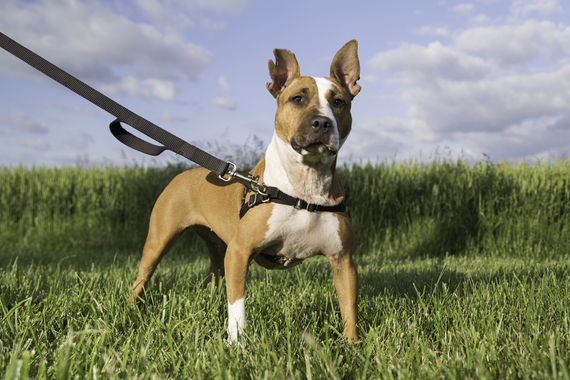 Belle was found by animal control officers in Cleveland with pieces of her jaw missing, and her face and body torn to shreds. The investigation regarding her condition is still ongoing. She was rehabilitated by the Animal Cruelty Task Force of Ohio.
Belle was found by animal control officers in Cleveland with pieces of her jaw missing, and her face and body torn to shreds. The investigation regarding her condition is still ongoing. She was rehabilitated by the Animal Cruelty Task Force of Ohio.
Throughout Pit Bull Awareness Month this past October, a war of words was waged between various groups online about the best way to protect pit bulls from abuse.
I won't give these organizations the credence of being named here, but I will briefly and succinctly spell out the two, basic arguments, and then throw in my two cents for whatever that's worth.
Premise:
Animal cruelty officers and shelter workers are quick to point out that pit bulls and pit bull-type dogs are the number one dog to be used by dog fighters, and to be abused by the public at large and then dumped at shelters. Therefore:
Solution 1
1. The way to fight this abuse and cruelty and to protect pit bulls, is to legislate mandatory spay/neuter laws just against this breed (except, "pit bull" isn't a breed, but never mind details for now), to euthanize most of the pit bull and pit bull-type dogs currently in shelters to make sure that nothing bad ever happens to them again (and all undefined mixes thereof with any sort of blocky head), and to promote legislation that restricts or bans their ownership in municipalities. Because we care.
Solution 2
2. The way to fight this abuse and cruelty and to protect pit bulls is to promote breed-neutral, dangerous dog ordinances that focuses on enforcing dangerous dog ordinances regardless of appearance rather than enforcing ordinances based solely on appearance; to promote spay/neuter programs for pit bulls and provide education and assistance to the lower-income demographics most likely to need help, and to be more proactive in the fight against animal cruelty by holding owners accountable, strengthening offenses for those who commit animal cruelty. Finally, rather than euthanasia out of compassion, while euthanasia will remain an unfortunate reality for some dogs, the focus needs to be on collaboration between no-kill rescues, limited intake humane societies and open intake shelters rather than division between these groups, to encourage partnerships that allow as many rescues and adoptions of pit bull and pit bull-type dogs that are flooding shelters, as well as every other dog. Because we care.
Here's the thing, though. Here's my two cents, if you're still with me.
Out of all the noise about what animal cruelty officers experience on a daily basis, rescuing animals found in the worst situations and left there by the worst people imaginable, I know nobody that takes the first position who is actually an animal cruelty investigator.
So with all due respect, stop speaking for us.
Because you see, I am an animal cruelty investigator. And I'd like to explain what I do a little better, and how I do it.
I am sworn in by the local probate judge, with full police powers, to investigate anyone suspected of animal cruelty or neglect in my county. This covers a broad spectrum of offenses; from the nefarious dog fighters to the backyard breeders who generally keep animals in substandard conditions, selling them prior to eight weeks of age, ignoring their medical concerns, and are responsible for other neglect/cruelty violations.
Dog fighters and backyard breeders. The two groups that everyone agrees are most responsible for the damage done to this beautiful dog, myself and my colleagues have the ability to do something about!!!
I have arrest powers in my state, and I have successfully thrown people in jail in my county for abusing animals. Sadly, I do find a lot of pitiful looking pitties while patrolling, as well.
I am paid, by state law set in the 1950s, for this critical function of law enforcement -- $25/month.
Twenty. Five. Dollars.
$300 a year.
No matter how many hours I work, cases I investigate, or time I spend in court, I drive my own vehicle -- on my own dime -- to proactively fight for these animals in a way that nobody else does who is being so vocal about the problem and solution.
- Well, that sucks but that's the way it's always been.
- Well, that sucks but if you didn't want the job you shouldn't have picked it.
The very concept of progress defies the logic surrounding the first position. The fact that I love this job so much, and that I want to see animals protected by the laws already on the books, is why I'm so vocal. I believe we can do better as a society for the animals entrusted in our care and I see the biggest opportunity, with those who have their boots on the ground doing the job already.
I'm not complaining. But if you want to know why we have a problem with pit bulls, here's one of the 800lb gorillas nobody wants to discuss: this is the only function of public law enforcement that requires private funds to conduct its job. This is why we have such a problem with animal cruelty and abuse/neglect. Three-hundred dollars will barely cover the vetting for one dog. My organization rescues hundreds of animals each year, from cats to cows and everything in between. We've spent thousands upon thousands upon thousands of dollars rehabilitating animals like the one below:
You see, national animal organizations have no local authority to seize animals. If you call any of the national organizations to complain about animal cruelty in my county, they have to defer to myself and the Sheriff because we have the legal authority to prosecute offenders.
The national organizations can assist in large scale cases, and many times they do. I have personally deployed with the ASPCA's Field Investigation and Response Team twice on large scale cases, once in Florida with over 700 cats and once in Ohio with over 400 dogs, and the benefit they provide to local organizations can be invaluable in these situations. Many times those groups will spend millions of dollars on one large case that a small organization would never be able to absorb.
If we want to make a dent in animal cruelty, if we want to go after dog fighters and if we want to protect pit bulls, when are we as a society going to make sure that the people who are entrusted to these positions actually have the resources to do their job?
In many counties in Ohio, $25 a month isn't enough to recruit and retain high-quality investigators. In many rural counties, it isn't enough to recruit and retain anyone. That means that for hundreds of thousands of animals, just in my state, there is nobody to investigate substandard backyard breeding conditions. Nobody to investigate dog fighters. Nobody to investigate neglect. Nobody to protect those who have no voice.
Instead of focusing on new legislation to ban a broad spectrum of dogs based on their appearance and using skewed and highly debated "statistics," why don't we look at better funding for animal cruelty investigators and humane societies? Why don't we support the people who can arrest those responsible for animal cruelty and neglect in our communities every single day?
If we can't properly fund what we already have laws for, how effective will any new laws be? If the focus is truly on keeping communities safe rather than winning the big pit bull debate of the decade, if we truly value the animals we spend billions of dollars on each year as pets, paying rural Ohio Humane Agents more than $25 a month should be a no-brainer.
And everywhere else.

